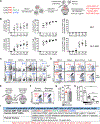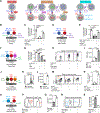Development of Hematopoietic Stem Cell-Engineered Invariant Natural Killer T Cell Therapy for Cancer
- PMID: 31495780
- PMCID: PMC7018522
- DOI: 10.1016/j.stem.2019.08.004
Development of Hematopoietic Stem Cell-Engineered Invariant Natural Killer T Cell Therapy for Cancer
Abstract
Invariant natural killer T (iNKT) cells are potent immune cells for targeting cancer; however, their clinical application has been hindered by their low numbers in cancer patients. Here, we developed a proof-of-concept for hematopoietic stem cell-engineered iNKT (HSC-iNKT) cell therapy with the potential to provide therapeutic levels of iNKT cells for a patient's lifetime. Using a human HSC engrafted mouse model and a human iNKT TCR gene engineering approach, we demonstrated the efficient and long-term generation of HSC-iNKT cells in vivo. These HSC-iNKT cells closely resembled endogenous human iNKT cells, could deploy multiple mechanisms to attack tumor cells, and effectively suppressed tumor growth in vivo in multiple human tumor xenograft mouse models. Preclinical safety studies showed no toxicity or tumorigenicity of the HSC-iNKT cell therapy. Collectively, these results demonstrated the feasibility, safety, and cancer therapy potential of the proposed HSC-iNKT cell therapy and laid a foundation for future clinical development.
Keywords: HSC; HSC transfer; HSCT; T cell receptor; TCR; cancer immunotherapy; cell therapy; gene therapy; hematopoietic stem cell; iNKT; invariant natural killer T cell; preclinical development; sr39TK suicide gene; stem cell therapy.
Copyright © 2019 Elsevier Inc. All rights reserved.
Conflict of interest statement
DECLARATION OF INTERESTS
Y.Z., D.J.S, and L.Y. are inventors on patent(s) relating to this study filed by UCLA. D.J.S. and S.D.B. are currently employees of Kite, a Gilead Company. F.U. is currently an employee of PACT Pharma. S.H. is a consultant for Amgen and Merck. S.M.L. is on the speaker bureau for Takeda and is a consultant for Bristol-Meyers Squibb. J.R.H is a founder and board member of Isoplexis and PACT Pharma. C.G.R. is a founder and stockholder of Sofie Biosciences and Trethera Corporation. A.R. is a consultant for Amgen, Bristol-Meyers Squibb, Chugai, Genentech-Roche, Merck-MSD, Novartis, and Sanofi; a scientific advisory board member and stockholder for Advaxis, Apricity, Arcus, Bioncotech, Compugen, CytomX, Five Prime, FLX-Bio, ImaginAb, Isoplexis, Kite-Gilead, Merus, and Rgenix; and a co-founder and scientific advisory board member of Lutris, PACT Pharma, and Tango therapeutics. D.B.K. is an inventor on intellectual property licensed by UCLA to Orchard Therapeutics and is a member of their Scientific Advisory Board; D.B.K. is also a scientific advisory board member of Allogene Therapeutics. O.N.W. is a consultant, stockholder, and/or board member with Trethera Corporation, Kronos Biosciences, Sofie Biosciences, and Allogene Therapeutics. All other authors declare no competing interests. None of the declared companies contributed to or directed any of the research reported in this article.
Figures







Comment in
-
Engineered Stem Cells Provide Cancer-Killing iNKT Cells.Cell Stem Cell. 2019 Oct 3;25(4):454-455. doi: 10.1016/j.stem.2019.09.005. Cell Stem Cell. 2019. PMID: 31585091
Similar articles
-
Development of allogeneic HSC-engineered iNKT cells for off-the-shelf cancer immunotherapy.Cell Rep Med. 2021 Nov 16;2(11):100449. doi: 10.1016/j.xcrm.2021.100449. eCollection 2021 Nov 16. Cell Rep Med. 2021. PMID: 34841295 Free PMC article.
-
Development of off-the-shelf hematopoietic stem cell-engineered invariant natural killer T cells for COVID-19 therapeutic intervention.Stem Cell Res Ther. 2022 Mar 21;13(1):112. doi: 10.1186/s13287-022-02787-2. Stem Cell Res Ther. 2022. PMID: 35313965 Free PMC article.
-
Genetic engineering of hematopoietic stem cells to generate invariant natural killer T cells.Proc Natl Acad Sci U S A. 2015 Feb 3;112(5):1523-8. doi: 10.1073/pnas.1424877112. Epub 2015 Jan 20. Proc Natl Acad Sci U S A. 2015. PMID: 25605948 Free PMC article.
-
Novel Approaches to Exploiting Invariant NKT Cells in Cancer Immunotherapy.Front Immunol. 2018 Mar 2;9:384. doi: 10.3389/fimmu.2018.00384. eCollection 2018. Front Immunol. 2018. PMID: 29559971 Free PMC article. Review.
-
CAR-iNKT cell therapy: mechanisms, advantages, and challenges.Curr Res Transl Med. 2025 Jan-Mar;73(1):103488. doi: 10.1016/j.retram.2024.103488. Epub 2024 Dec 4. Curr Res Transl Med. 2025. PMID: 39662251 Review.
Cited by
-
Immune-based Therapies for Hematological Malignancies: An Update by the EHA SWG on Immunotherapy of Hematological Malignancies.Hemasphere. 2020 Jun 29;4(4):e423. doi: 10.1097/HS9.0000000000000423. eCollection 2020 Aug. Hemasphere. 2020. PMID: 32904089 Free PMC article. No abstract available.
-
Challenges and new technologies in adoptive cell therapy.J Hematol Oncol. 2023 Aug 18;16(1):97. doi: 10.1186/s13045-023-01492-8. J Hematol Oncol. 2023. PMID: 37596653 Free PMC article. Review.
-
Allogeneic CD33-directed CAR-NKT cells for the treatment of bone marrow-resident myeloid malignancies.Nat Commun. 2025 Feb 1;16(1):1248. doi: 10.1038/s41467-025-56270-6. Nat Commun. 2025. PMID: 39893165 Free PMC article.
-
Generation of dual-attribute iTNK cells from hPSCs for cancer immunotherapy.Cell Rep Methods. 2024 Sep 16;4(9):100843. doi: 10.1016/j.crmeth.2024.100843. Epub 2024 Aug 30. Cell Rep Methods. 2024. PMID: 39216483 Free PMC article.
-
Adoptive Immunotherapy With Engineered iNKT Cells to Target Cancer Cells and the Suppressive Microenvironment.Front Med (Lausanne). 2022 May 9;9:897750. doi: 10.3389/fmed.2022.897750. eCollection 2022. Front Med (Lausanne). 2022. PMID: 35615083 Free PMC article. Review.
References
-
- Baltimore D, Witte ON, Yang L, Economou J, and Ribas A (2010). Overcoming barriers to programming a therapeutic cellular immune response to fight melanoma. Pigment Cell Melanoma Res. 23, 288–289. - PubMed
-
- Bendelac A, Savage PB, and Teyton L (2007). The biology of NKT cells. Annu. Rev. Immunol 25, 297–336. - PubMed
-
- Berzins SP, Smyth MJ, and Baxter AG (2011). Presumed guilty: natural killer T cell defects and human disease. Nat. Rev. Immunol 11, 131–142. - PubMed
Publication types
MeSH terms
Substances
Grants and funding
LinkOut - more resources
Full Text Sources
Other Literature Sources
Medical

